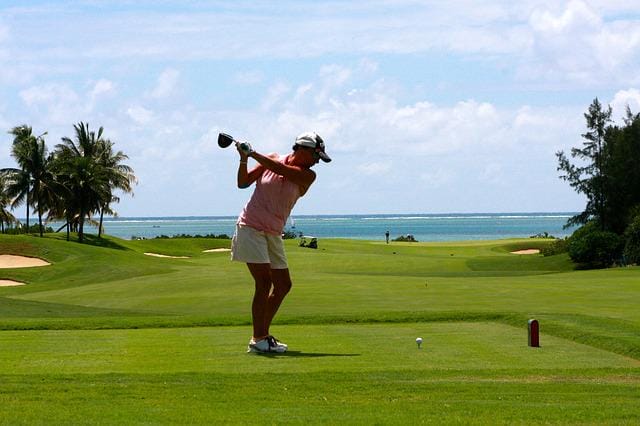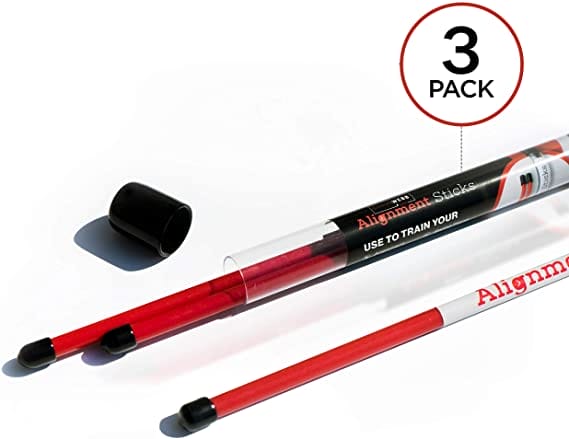As a golfer, you will eventually learn that hitting the ball straight is not always the solution. There are times when it makes quite a bit of sense to hit a shot that can turn a little left or a slight right. The golf draw vs. fade discussion is a popular one that will impact the type of shot that you need to play for your game. Both a gold draw and a fade can be a good solution; the key is to choose one that is the best fit for your game. Let’s take a look at what a draw is, what a fade is, and the draw vs. fade situation for players.
What is a Draw in Golf?

A golf draw is a shot that starts out straight at the target and then turns to the left. The draw is a controlled shot and not a hook. With the golf draw, expect to get a ball flight that is considerably longer than a fade and sometimes slightly lower.
For a golf draw to be effective, a golfer must know that they are hitting it. For instance, when you hit a golf shot that simply goes left, it isn’t an intentional draw.
Players that struggle with swing plane issues will have a hard time getting themselves to hit a draw. When you hit a draw, your swing must be on the proper plane.
PROS
- Easy to hit the ball further
- Can help with dogleg type holes
- Will mean that the swing is in place
- It helps golfers hit shots from the inside out
- Helpful with improving total driver distance
CONS
- Not a great shot for backspin
- Can cause issues with the ball rolling through a green
How to Hit a Draw?
Now that you can see the benefits of hitting a draw, it’s time to learn how to hit a draw. The good news is that hitting a draw in golf is not as difficult as you think. There are several different ways to accomplish this, but most of them require minor adjustments to your swing. This is the simplest way to hit a draw but feel free to look into other options that work for your natural abilities.
Step 1: Setup
For the golf draw, you will want to set up aiming slightly right of your target. The idea will be to swing along this line with a square clubface. The results will help you get the ball flight to turn to the left.
Step 2: Adjust Club Head
The clubface of the golf iron or driver that you are trying to draw should still be facing the target. The idea is to keep your swing on a nice shallow plane that keeps the club hitting from the inside out. In addition, golfers need to be sure they do not change their stance and leave their feet aiming to the right of the target.
Step 3: Takeaway
The takeaway needs to be a little lower when hitting a draw. If you take the club a bit too upright, the overall ball flight will be more of a fade. Keeping the club a little lower and taking the club back slow is a much quicker adjustment for the average golfer than trying to learn too much advanced theory about swing mechanics.
Step 4: Shallow Swing
With a draw, you need to hit the shot from the inside out. Make sure that you allow your elbow to drop down and fall into place, increasing the golfer’s ability to swing out and away towards the target. The shallow swing is considered stronger and will be a great thing for players to continually practice and perfect.
Step 5: Finish It
So many golfers make the mistake of getting nervous about their swing as they finish the shot. If you choose to hit the draw shot, you must stick with it all the way through. If you don’t fully complete and finish the swing, your golf shot may come up short, or it may not draw at all.
When aiming the draw, we highly recommend aiming at the right side of the green and then letting the ball draw towards the middle of the green. If you aim too far to the right and then have trouble controlling the draw or miss-hit the shot, you will leave yourself in a much worse condition.
When Should you Hit a Draw?
When you have a pin on the left side of the green, it is the perfect time to hit a draw. Simply aim for the center and watch the ball end up right next to the pin. Hitting a draw is an excellent shot for golfers of all playing abilities.
It can be used off of a tee box when playing on a course that has a dog-left type shot. The hole can be made considerably shorter if you can learn to cut the corner and work the ball with a draw.
When you need a lot of spins and are worried about a shot rolling over the green, stay away from the draw. The idea is that the draw will have a hard time stopping on greens at times because of the lack of spin.
What is a Fade in Golf?

The fade is a shot that starts out straight at the target and then turns a bit to the right. The fade is a very popular shot because it gives players considerable control in their swing.
In addition, golfers that hit a fade are often going to be using their natural swing path to complete this shot. The fade tends to be more realistic for golfers because it is a bit more of an upright swing.
Players that learn how to hit a fade on demand will be much more likely to be able to fix their slice or even a hook. If you want higher ball flight and more precision in your game, the fade is the golf shot to learn next.
PROS
- Easy to learn
- Can have higher spin and ball flight
- Provides golfers more control
- Perfect for a dog let right holes
CONS
- It will be slightly weaker than a draw
- It can quickly turn into a slice
How to Hit a Fade?
Learning to hit a fade does not need to be complicated. However, golfers will need to practice this before taking it out on the course. When learning to hit both draws and fades, there is a certain amount of feel involved. If you are not good at feel and managing how to hit these types of shots, you may fade or draw the ball too much.
Here are just one of the many ways to hit a fade. If you are serious about implementing this shot into your game, you may have to try a few different methods.
Step 1: Setup
When hitting a fade, you will do the opposite of what you do with a draw. Instead of aiming to the right of the target, you will aim to the left of the target. The stance will feel a bit open, but the clubface will be aimed at the target.
The amount you aim to the left will impact the type of fade shot that you get. Don’t let this get out of hand, as you may end up hitting a shot that turns from a fade to a slice.
Step 2: Swing Plane and Path
The fade swing path or swing plane will be more upright than it is with the draw-type shot. This golf shot requires a more upright golf swing with a steeper plane.
It is best to keep your clubface square and just picture that your club is coming up a little higher in the backswing and a bit more upright.
Again, golfers always need to be aware of the issues with overdoing it. If you take the club too steep, you are almost going to be guaranteed a slice shot. The slice is much harder to recover from and causes major issues.
Step 3: Swing To Target and Finish
With the fade shot, you must finish your golf swing. The fact that you will complete your swing and then be finished facing your target will help ensure that you get the ball to fade with the high ball flight and impressive spin.
Golfers should think about swinging out towards the target. There is no need to swing out to the left where your feet are; simply take a more upright swing path, and the rest of the shot will work out for you.
Fade shots are not all going to have the same amount of fade, and players need to practice to learn how much the ball will turn and why it is so important to turn the golf ball.
When Should you Hit a Fade?
Fade shots are best when the flag is on the left side of the green. You can hit a shot that flies into the center of the hole and then fades right towards the target. This is an excellent solution because it allows golfers to aim for the center of the green but still get close to the hole.
Fades are great when you need a higher ball flight and some extra spin on your shots. In addition, for a dog leg right, you can use the fade to cup off a considerable amount of distance to the hole.
Some golfers will find that the fade is a really good fit for them, and they will continue to use this shot regardless of the hole they are on. If your natural ball flight is a fade, you can absolutely play each round with a fade.
Which One Is Better – Fade or Draw
Many golfers want to know if a fade or a draw is better. The most important thing to remember here is that both the fade and the draw are good. The key is to know how to hit both and to know when to hit them.
Anytime you are unsure how to hit a golf shot, you miss an opportunity to pull off a great shot. Golfers do not need to overdue the fade and draw thing and instead should look at the golf shot they have in front of them and which makes the most sense to hit.
Here are a few key tips to keep in mind.
- Hit a fade if the pin is on the right side of the green
- Hit a draw if the pins are on the left side of the green
- Hit a fade if you need the ball to stop right away
- Hit a draw if you want maximum distance
- Hit a fade if you want precision and control
- Hit a draw if you want power
Draw vs. Fade For Lefties
The lefty golfer needs to be careful about what they think of a draw and a fade. For a lefty, things are backward, so the draw will not fall to the left; it will fall to the right.
With the fade, lefties can expect the golf shot to turn towards the left as it falls instead of turning towards the right. The lefty stands on the opposite side of the ball and has different swing plane issues than the right handed golfers.
The lefty player will still want to hit both the draw and the fade golf shots to take their game to the next level.
Stopping an Accidental Draw or Fade?
Sometimes you may be hitting a draw or a fade when you don’t want to. This is quite common in golf and, luckily, can be quite easily fixed. If you are hitting an accidental draw or fade, you must work your way back from the steps we talked about to hit a draw or a fade. Here are the key things to look for.
Stance/Setup
The stance and setup of the swing must be square. If you are hitting a draw or a fade without planning to hit this type of shot, chances are your setup is no longer square. Look and see how your hips, feet, and shoulders are aligned so that you can get them back on track.
Swing Plane
As we mentioned, the swing plane for a draw type shot is more shallow, and the fade type shot is more upright. If you are hitting accidental draws or fades, chances are your swing plane is slightly off. Many golfers think this has to do with the golf clubs they are playing with, but it is likely due to swing planes. Believe it or not, even a brand new impressive technology driver can slice or hook.
Club Face Angle
Check your clubface angle to make sure that it is square. Remember that even when we tried to hit a draw or a fade shot, we kept the clubface primarily square. This is essential in any golf shot you hit to ensure that the ball heads towards the target the way it should.
Methods to Improve Your Draw and Fade Shots
Now that you have the basics on how to hit a draw or a fade shot, here are some tips to help improve your abilities and make sure that you start using this information on the golf course.
Practice Before Course
Never try to start hitting a draw or fade golf shots on the course. You will need to practice at the driving range before you take it to the course. Since the fade and draw can turn into a hook or a slice, it takes a bit of time to perfect these shots.
Video The Swing
Some golfers are visual learners. If you are a visual learner, you should take the time to video your swing. Sometimes seeing where the club head is and how the golf shaft is angled can really help you make the necessary adjustments in your game. Remember that golf swings don’t require significant adjustments to become much better.
Golf Alignment Stick

A golf alignment stick can be a great option to use to practice the draw and the fade. With a golf alignment stick, you can practice your aiming, your ball flight, and your ability to get the club on the proper swing plane. There are many options on the market for golf alignment sticks, and they can stay in your bag until you are ready to practice and work on your game.
Conclusion
We hope you now clearly see the difference in the golf draw vs. fade. Playing golf is not nearly as simple as it looks, and it takes a variety of golf shots to complete a great round of play. If you are new to the game and still working on hitting the ball straight, you may want to take some time to hit the ball left and right. Learning to control the ball will only help you take your golf game to the next level. If you want golf professionals on television, you will see that they use the draw and fade shot quite often.

